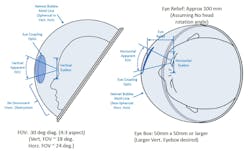Wanted: augmented reality helmet-mounted display to help astronauts do tasks while outside the spacecraft
CLEVELAND – U.S. space researchers are asking industry to develop an augmented reality display system for use on the bubble of an astronaut's spacesuit helmet to help space crews make quick decisions without help from mission controllers on Earth.
Officials of the National Aeronautics and Space Administration (NASA) Glenn Research Center in Cleveland issued a request for information (80GRC023R0002) last month for the Joint Augmented Reality Visual Informatics System project.
This spacesuit augmented reality display system would be a spacesuit-compatible augmented reality system with display, control, and computer subsystems to help astronauts complete tasks while they are working outside of their spacecraft.
Augmented reality (AR) blends a view of the physical world with digital images, video, text, or other information. It helps produce visual overlays to imagery, or provides written information beside what the viewer sees, such as a digital repair manual application.
Related: Department of Defense invests in delivering augmented reality technology to foot soldiers
Future suited crew operations must be self-reliant because communications delays in space slow the ability for crew members to interact with Earth-based mission control in real-time.
In the near-term, such a space helmet-mounted display could enable communications between crew and mission control by adding dynamic visual cueing. In the long-term, this display could help enable interplanetary human exploration by supplementing -- and in some cases replacing -- Earth-based mission support, and enable the crew to make quick decisions on their own.
NASA researchers would like to develop ability to display information comfortably to the suited crew member via a minimally intrusive see-through display located on the helmet bubble about four inches from the astronaut's eyes. Researchers are not considering head-worn displays for this project.
Instead, the spacesuit augmented reality display system would work like a fighter pilot's head-up display, except the spacesuit helmet volume prohibits conventional HUD designs. It also will require an eye-box much larger than typically seen for head-worn systems.
The eye box should be 50 by 50 millimeters, or larger; have at least a 30-degree field of view; eye relief of 40 to 100 millimeters; brightness of at least 1,000 nits; weigh no more than four pounds; and use no more than five Watts of power.
Elements within the helmet-bubble must be compatible with a 100 percent oxygen atmosphere. Powered elements within the 100 percent oxygen will subjected to special scrutiny to mitigate flammability and safety concerns. System elements must be rugged enough to operate in vacuum, dust, radiation, and extreme thermal environments.
Researchers also would like the display to mitigate vergence-accommodation conflict, which means that astronauts should be able to view information while gazing at far-away objects. Crew members should be able to use the display comfortably for as long as eight hours.
Related: Air Force selects AVATAR Partners for augmented- and mixed-reality inspection
From industry, researchers would like answers to four questions: how existing augmented reality systems can be modified or scaled to meet requirements; how technologies under development could meet key optical requirements inside a space helmet; which requirements pose the most technically difficult challenges; and how the display could influence spacesuit design and meet environmental requirements.
Companies interested should email responses no later than 17 March 2023 to NASA's Rita Dickens at [email protected].
Email questions or concerns to Rita Dickens, the NASA Joint Augmented Reality Visual Informatics System contracting officer, at [email protected]. More information is online at https://sam.gov/opp/3d2c644875e04a21bb40ae765afbdd26/view.
About the Author
John Keller
Editor-in-Chief
John Keller is the Editor-in-Chief, Military & Aerospace Electronics Magazine--provides extensive coverage and analysis of enabling electronics and optoelectronic technologies in military, space and commercial aviation applications. John has been a member of the Military & Aerospace Electronics staff since 1989 and chief editor since 1995.

